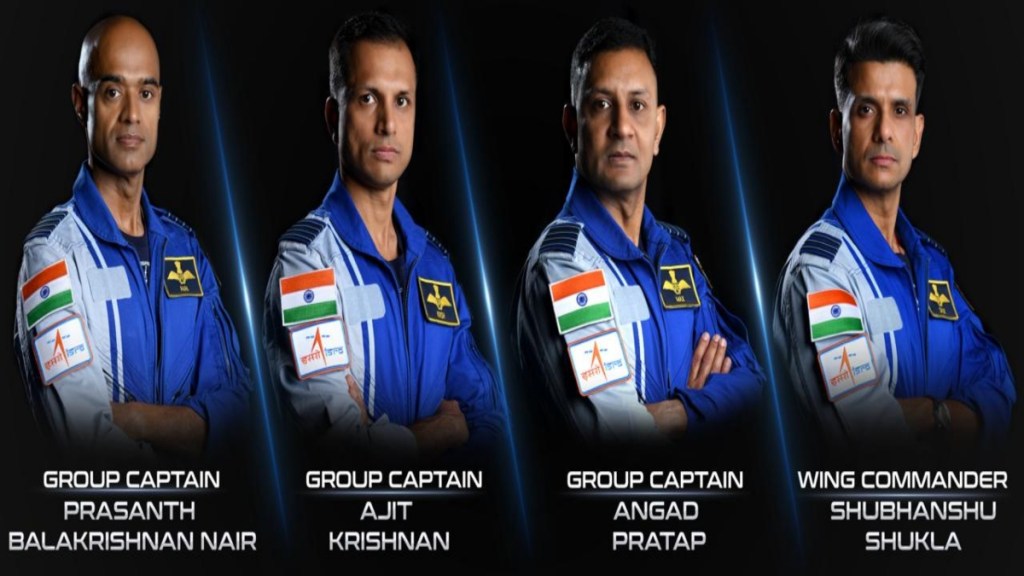India has announced the names of the four Indian Air Force (IAF) Test Pilots who are going to be the astronauts for the Gaganyaan mission to space.
The four chosen IAF pilots are: Gp Capt Prashanth Nair; Gp Capt Ajit Krishnan; Gp Capt Angad Pratap; and Wg Cdr Shubhanshu Shukla. During the inaugural ceremony held today at the Vikram Sarabhai Space Centre, Thiruvananthapuram, Prime Minister Narendra Modi unveiled the Indian Astronaut Logo and awarded the ‘अंतरिक्ष यात्री पंख‘ (Wings) to the four IAF Astronauts.
It has been reported previously by Financial Express Online regarding the inclusion of female candidates, a senior IAF officer had pointed out the dearth of women with adequate experience as fighter or test pilots.
On its social media platform, the Indian Air Force made a significant announcement, declaring its partnership with the Indian Space Research Organisation (ISRO) to realize the nation’s ambitious goal of conducting a Manned Space Flight mission.
All you want to know about the four Astronauts
Subsequently, the Air Force disclosed detailed information about four astronauts selected for this historic mission. All of them are proud alumni of the National Defence Academy (NDA) and belong to the esteemed fighter stream of the Air Force.
Group Captain Prasanth Balakrishnan Nair, born on August 26, 1976, in Thiruvazhiyad, Kerala, stands as a distinguished figure among them. A recipient of the Sword of Honour at the Air Force Academy, he was commissioned into the fighter stream on December 19, 1998. With an impressive flying record of approximately 3000 hours, he serves as a Cat A Flying Instructor and a Test Pilot, showcasing expertise across various aircraft types, including Su-30 MKI, MiG-21, MiG-29, Hawk, Dornier, and An-32. His professional journey also includes attending the United States Staff College and commanding a premier fighter Su-30 Squadron.
Group Captain Ajit Krishnan, born on April 19, 1982, in Chennai, Tamil Nadu, is another distinguished NDA graduate. Honoured with the President’s Gold Medal and Sword of Honour at the Air Force Academy, he was commissioned into the fighter stream on June 21, 2003. With nearly 2900 hours of flying experience, he serves as a Flying Instructor and Test Pilot, boasting proficiency in handling Su-30 MKI, MiG-21, MiG-29, Jaguar, Dornier, and An-32 aircraft. He is also an alumnus of DSSC, Wellington.
Group Captain Angad Pratap, born in Prayagraj on July 17, 1982, shares a similar trajectory, having graduated from NDA and commissioned into the fighter stream on December 18, 2004. With around 2000 hours of flying experience, he excels as a Flying Instructor and Test Pilot, having operated various aircraft, including Su-30 MKI, MiG-21, MiG-29, Jaguar, Hawk, Dornier, and An-32.
Wing Commander Shubhanshu Shukla, born on October 10, 1985, in Lucknow, Uttar Pradesh, completes this remarkable quartet. Commissioned into the fighter stream on June 17, 2006, he serves as a Fighter Combat Leader and Test Pilot, showcasing approximately 2000 hours of flying expertise across different aircraft types, including Su-30 MKI, MiG-21, MiG-29, Jaguar, Hawk, Dornier, and An-32.
The Down Selection & Training – The Journey
In 2019, after completing rigorous training at the Institute of Aerospace Medicine (IAM), the Indian Air Force (IAF) identified ten officers, from whom these four were eventually selected for India’s pioneering manned mission, Gaganyaan, scheduled for 2022.
The Mission got delayed for various reasons including a renewed focus on investigating the setbacks encountered during the Chandrayaan-2 mission and global lockdown due to COVID-19 pandemic. Financial Express Online has reported previously that the final selection was done by IAF.
In collaboration with ISRO, the IAF formulated an elaborate roadmap for the selection and training of astronauts for India’s inaugural manned space mission.
Financial Express Online has also reported previously that only test pilots possessing robust psychological resilience, would be considered for the mission.
Confirming the selection process, a high-ranking IAF officer explained that it consisted of three phases, resulting in the shortlisting of ten candidates, out of which six would undergo advanced training in Russia. Initially, 100 candidates were assessed based on specific criteria, with only two eventually chosen to embark on the mission.
The selection process drew from volunteers and candidates with diverse aviation backgrounds, including flight engineers, pilots, fighter pilots, and test pilots.
For training in Russia, Roscosmos and ISRO signed an MoU, establishing a framework for collaborative efforts on the manned space mission. The final six candidates selected by the IAF underwent a short training module aboard a Soyuz spacecraft in Russia.
At IAM, test pilots underwent a comprehensive series of assessments, including rigorous physical evaluations, radiological screenings, and psychological tests.
Regarding the Gaganyaan mission:
– Astronauts would be formally referred to as “Vyomanauts.”
– A GSLV MK-III launch vehicle would transport the orbital module.
– ISRO had outlined provisions for a three-member crew, although the exact number remained subject to confirmation.
– The overall project cost was estimated at Rs 10,000 crore, encompassing expenses related to technology development, flight hardware procurement, and the construction of critical infrastructure.
– ISRO had allocated Rs 173 crore for the development of essential technologies critical to the success of the mission.
– Achieving the objectives of the Gaganyaan program necessitated collaboration with national agencies, research laboratories, academic institutions, and industry partners.
The training of the four IAF pilots in Russia, initially planned for an 11-month duration, was temporarily put on hold due to the global COVID-19 pandemic. The mission aims to transport astronauts into low Earth orbit from India.
The Russian Training Centre offered specialized equipment and simulation facilities for mission-specific training, encompassing astro-navigation, weightlessness adaptation, exposure to gravitational forces, underwater operations in a simulated spacecraft environment, and simulated control center operations. These facilities aimed to provide astronauts with hands-on experience and familiarity with the conditions they would encounter during their spaceflight mission.

